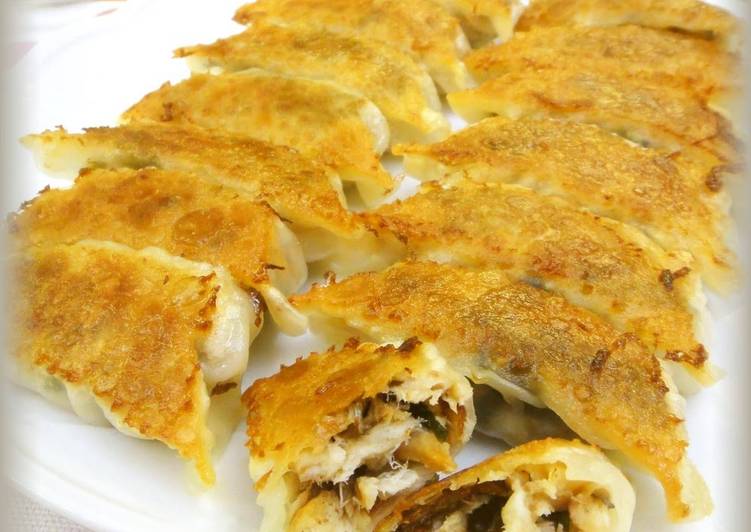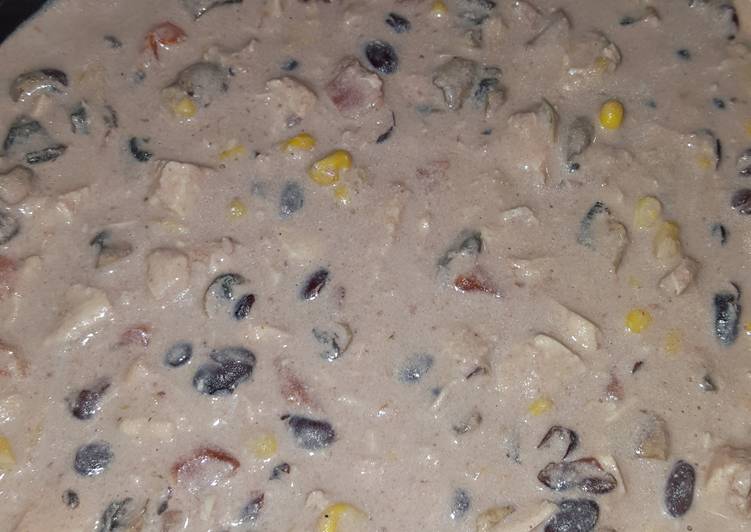
Hello everybody, it’s me, Dave, welcome to my recipe page. Today, I will show you a way to prepare a distinctive dish, salted mackerel and umeboshi gyoza dumplings. It is one of my favorites. For mine, I am going to make it a bit unique. This is gonna smell and look delicious.
Salted Mackerel and Umeboshi Gyoza Dumplings is one of the most well liked of recent trending meals in the world. It’s appreciated by millions daily. It’s simple, it’s fast, it tastes delicious. They’re nice and they look fantastic. Salted Mackerel and Umeboshi Gyoza Dumplings is something that I’ve loved my entire life.
Salted Mackerel and Umeboshi Gyoza Dumplings I thought up this recipe for a friend who doesn't like meat. It's amazingly delicious, and is a family favorite now. The dumplings are already well flavored, so please enjoy them as-is with no dipping sauce.
To begin with this particular recipe, we have to first prepare a few components. You can have salted mackerel and umeboshi gyoza dumplings using 7 ingredients and 8 steps. Here is how you can achieve that.
The ingredients needed to make Salted Mackerel and Umeboshi Gyoza Dumplings:
- Prepare 2 pieces Salted mackerel
- Make ready 2 medium Umeboshi
- Take 5 to 10 Shiso leaves
- Take 1 tbsp Sesame oil
- Prepare 15 Gyoza skins
- Get 2 tbsp Sesame oil to cook the dumplings
- Prepare 2 tbsp Sesame oil for finishing
Yes, gyoza is originally from Chinese fried dumplings, but it is so popular and rooted well in Japanese cooking today. Jiaozi (Chinese: 餃子; [tɕjàu.tsɨ] ()) are a kind of Chinese dumpling, commonly eaten in China and other parts of East Asia. They are one of the major dishes eaten during the Chinese New Year and year-round in the northern provinces. Though considered part of Chinese cuisine, jiaozi are popular in other parts of East Asia and in the Western World..
Steps to make Salted Mackerel and Umeboshi Gyoza Dumplings:
- Cook the mackerel on both sides until browned. I pan fried them in a frying pan. You can microwave or grill them if you like!
- Flake the fish. Chop up the umeboshi (pits removed). Finely chop the shiso leaves. You can add some of the fish skin, finely chopped, if you like - it's delicious!
- Put all the ingredients in step 2 in a bowl and mix with 1 tablespoon of sesame oil. Make the gyoza dumpings.
- Heat 2 tablespoons of sesame oil in a frying pan and put the gyoza dumplings in.
- Turn up the heat to high. Add enough water to cover the bottom of the frying pan. Cover with a lid and steam-cook the dumplings. Turn down the heat to medium about halfway through.
- When all the water in the pan is gone, drizzle the remaining 2 tablespoons of sesame oil over the dumpings. Put the lid back on and cook until the dumplings are crispy and browned on the bottom. Done!
- The gyoza dumplings look like this on the inside.
- These appeared on a recipe card issued by Moranbon (a famous yakiniku barbecue chain in Japan).
Recipe : Dashi poached mackerel, soy infused shiitake and tofu gyoza, Granny Smith apple Mackerel is a rich, oily fish that stands up well to the pronounced Asian flavours in this dish. Here the mackerel is served with ginger and spring onion spiced, shiitake and tofu gyoza and finished with fresh crisp apple and garnished with apple blossom. As far as dumplings go, Japanese-style gyoza are some of the simplest to make, if only for the fact that they are almost always made with store-bought, ready-to-fill wrappers at even the best dumpling joints in Japan. Fresh dough that's rolled with a rolling pin is wonderful for Chinese-style fried dumplings like guo tie, but gyoza demand thinner, stretchier dough that is rolled pasta-style by. The addictive Gyoza (dumpling) sauce is usually sold premade in bottles at the Asian food store.
So that’s going to wrap this up for this exceptional food salted mackerel and umeboshi gyoza dumplings recipe. Thank you very much for your time. I am confident you can make this at home. There is gonna be more interesting food at home recipes coming up. Remember to save this page in your browser, and share it to your family, colleague and friends. Thanks again for reading. Go on get cooking!

